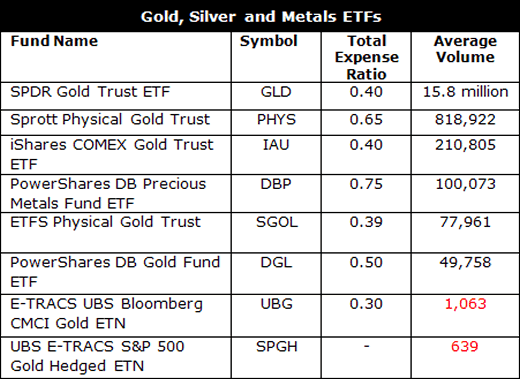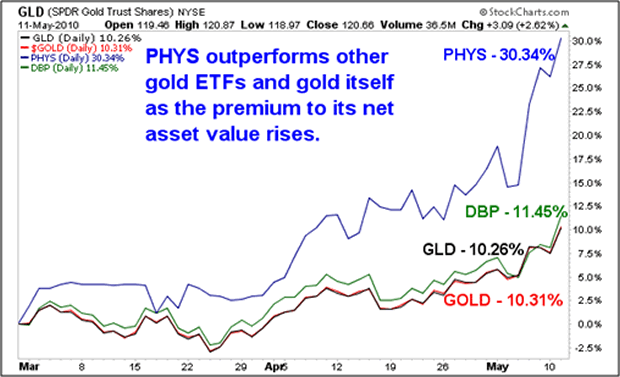3 Things to Check BEFORE Trading Gold ETFs
Commodities / Gold and Silver 2010 May 14, 2010 - 08:22 AM GMTBy: Sean_Brodrick
 Gold sure looks like it’s on the launch pad, with my targets of $1,350 and $1,500 both in sight. Many investors would like to play that move with funds that claim to track physical gold — exchange-traded funds, or ETFs.
Gold sure looks like it’s on the launch pad, with my targets of $1,350 and $1,500 both in sight. Many investors would like to play that move with funds that claim to track physical gold — exchange-traded funds, or ETFs.
But there is peril as well as profit potential. Let me give you my take on the gold funds — and tell you the two that I wouldn’t touch with a 10-foot pole.
There are a bunch of gold ETFs. They all seem similar on the surface, but that’s not the case. The iShares, SPDR, ETFS and Sprott funds hold physical metal. Whether a fund like the GLD has all the gold it says it does is a subject of fierce and furious debate on the Internet.

PowerShares structures its funds differently. They track the performance of a fully collateralized futures position, meaning they capture changes in the spot price of the underlying metal plus any "roll yield" and interest income. If the metals do well, they will likely outperform. If the metals do poorly, they will likely underperform.
There are also leveraged gold exchange-traded notes, or ETNs. But I’ll save those for later.
Here Is the Run-Down on These Funds …
SPDR Gold Trust (GLD). The Big, Bad Voodoo Daddy of gold ETFs, the GLD generates equal parts of huge volume by people who believe it’s a great way to track gold prices and controversy as some detractors say it doesn’t own all the gold it says it does. The GLD recently held 38.323 million ounces of gold. That’s a lot!
Sprott Physical Gold Trust (PHYS). The newest physically backed gold exchange-traded product began trading on February 26th and is a rip-roaring success. It is not technically an ETF, as it doesn’t create or redeem units on a daily basis. As a result, it can trade at quite a premium to its net asset value, and recently that premium hit 20%. PHYS recently held 362,837 ounces of gold.
We’ll cover why the PHYS may be trading at such a premium to its NAV later in this article.
The gold for PHYS is stored at the Royal Canadian Mint. Interestingly, unit holders can, on a monthly basis, redeem their units for physical gold bullion in a minimum of one bar (350 to 430 troy ounces) for a redemption price equal to 100% of the net asset value minus expenses.
iShares COMEX Gold Trust ETF (IAU). This fund has labored in GLD’s shadow since 2005. Detractors make the same claim against IAU that they do against GLD — saying the fund has been covertly depleted of its physical holdings. IAU has 2.6 million ounces of gold in storage. Both IAU and GLD are priced to track 1/10th the price of gold, minus expenses.
PowerShares DB Precious Metals Fund ETF (DBP). This fund tracks an index that is a basket of gold and silver contracts.
ETFS Physical Swiss Gold Shares (SGOL). This fund began trading in the U.S. last year. Each share represents one-tenth of an ounce of gold bullion. So, SGOL sounds like a clone of GLD or IAU. But this fund’s gold is stored in Switzerland. William Rhind, an ETFS official, told the Wall Street Journal “With regard to terrorism, war, and all sorts of extreme events, the feeling is that Switzerland is probably the safest venue to store gold.”
PowerShares DB Gold Fund ETF (DGL). This fund tracks the DB Gold Index, and is basically a basket of gold contracts.
E-TRACS UBS Bloomberg CMCI Gold ETN (UBG). This is an exchange-traded note based on the performance of the UBS Bloomberg CMCI Gold Index. While it does have a low expense ratio, the volume on this fund is even lower, and I would avoid it.
UBS E-TRACS S&P 500 Gold Hedged ETN (SPGH). This “Frankenstein” fund does not seem well-thought out. It provides 200% long exposure, but not just to gold. Every dollar you invest in SPGH generates $1 in long exposure to gold and $1 in long exposure to the S&P 500. Why? There’s no good reason that I can see. Volume is abysmal. Avoid SPGH.
Now that you know what the funds are — and which to avoid — here are three more things you should consider …
3 Things to Check
#1) Volume — getting out is just as important as getting in. The higher the volume on a particular fund, the less the spread between the bid and the ask. This means you get better fills going in and getting out. GLD is THE most liquid gold ETF, and therefore one of the better vehicles for short-term trades.
Other funds have lower volume, which means poorer fills. UBG and SPGH have volume bordering on hopeless.
#2) Performance — not all funds perform equally, but some do. GLD, IAU, SGOL, and DGL all perform almost exactly the same, which is very close to gold itself. DBP does a little better because it holds silver as well as gold. But the real outperformance is in PHYS. Take a look at this chart, which tracks a bunch of gold funds from the debut of PHYS through Tuesday’s close …

Looking at this outperformance, you need to ask yourself, will this outperformance continue, or will PHYS’ performance come back in line with other gold ETFs? I think that correction will come when gold pulls back. And that could be an opportunity.
#3) Tax consequences — yes, yes, I know, talking about taxes makes everyone’s eyes glaze over. But gold ETFs have important tax considerations that you need to take into account before you buy.
ETFs that hold physical gold and silver fall under the heading of “collectibles” in the eyes of your friendly neighborhood Internal Revenue Service. This status means that profits from gold and silver investments do not qualify for the 15% maximum on long-term capital gains that pertain to stock and mutual fund investments.
These profits are instead taxed at a 28% maximum if held for more than a year, and at ordinary income rates if held for less than a year.
Also, when the ETF itself sells physical gold or silver, any gains or losses are passed along to investors, who then face the maximum 28% tax liability even if they didn’t actually realize the gain.
And gold ETFs that invest in gold futures — like DGL and DGP — have their own tax trip-ups. You must report gains each year to Uncle Sam even if you don’t sell the ETFs. So there’s no tax benefit. When you do pay, 60% of your gains are taxed at the long-term cap gains rate of 15% and 40% are taxed as short-term cap gains, which are taxed similarly to your ordinary income.
There are a couple of solutions to this. Be aware that I am not a registered tax advisor. But here’s what I’ve picked up along the way …
Solution #1: Buy your gold ETF in a tax-deferred account (like an IRA) to avoid the tax headache. A tax adviser or financial planner may have other solutions for you.
Solution #2: Buy a Canadian Fund. Canadian funds can offer tax advantages to U.S. investors.
Let’s take the PHYS as an example. The tax advantage in the prospectus states: “Any gains realized on the sale of units by an investor may be taxable as long-term capital gains (at a maximum rate of 15% under current law).” This would then avoid the 28% tax on collectibles also under current law. This may change with circumstances — a qualified tax specialist can tell you more about how to make this claim. But now you see why investors may think the PHYS is worth its premium to net asset value.
Another Canada-based fund, the Central GoldTrust (GTU on the NYSE) is structured as a trust that invests in audited physical gold held in the treasury vaults of the Canadian Imperial Bank of Commerce. It does not promise to make physical distributions of gold under certain circumstances, as GLD does. Therefore it is not a “collectible”. It qualifies as a passive foreign investment company with the IRS. You can make a qualified fund election by filing form 8621 (a 1-page form). This means you should get the 15% standard long-term capital gains treatment.
Solution #3: Buy an ETN. When an investor purchases an ETF, he is purchasing an asset like a commodity or index basket. When an investor purchases an ETN, he or she is purchasing a debt product (promissory note) similar to a bond. ETNs are taxed like ordinary stocks at year end, so no tax is due if you’re still holding them.
The terms of the debt contract are determined by the structure of the ETN. ETNs that are backed by a bank with a high credit rating are pretty secure products. However, in a worst-case scenario, you have a default risk.
UBG and SPGH are ETNs, but I wouldn’t recommend them. However, there are LEVERAGED gold ETNs. The DB Gold Double Long ETN (DGP on the NYSE) aims to track twice the movement in gold. Just be aware that a fire that burns twice as hot can burn you twice as badly, and boy, can you get burned by DGP when gold goes into one of its standard corrections.
And of course, if you think gold is about to go lower, you can use the DB Gold Double Short ETN (DZZ on the NYSE) or DB Gold Short ETN (DGZ on the NYSE).
Bottom Line: Currency and Debt Woes Should Pump Up Gold Prices
The so-called “risk-free” sovereign debt bubble has only recently begun to pop. The so-called PIIGS nations (Portugal, Ireland, Italy, Greece and Spain) have total sovereign debt of $3.9 trillion, according to the New York Times. As everyone from central banks to small investors pull money out of sovereign debt they formerly thought of as safe, they will likely rush to the real safety investment — gold.
Now you add in all the other forces moving gold: Investor demand, China’s growing middle class that is hungry for gold, currency risks, tightening supply — heck, we may have hit peak gold — and you can see that gold prices should trend higher. It probably won’t be in a straight line. So be patient and buy those pullbacks. This list of gold ETFs should give you a good place to start.
Yours for trading profits,
Sean
P.S. The precious metals positions I’ve recommended in my Crisis Profit Hunter newsletter are peeling rubber and roaring higher. I have more recommendations to make — and NOW is a great time to get on board.
What’s more, if you join now, you can get my special subscription price — just $89 for one year. If you haven’t signed up already, don’t waste another minute — get your subscription to Crisis Profit Hunter TODAY!
This investment news is brought to you by Uncommon Wisdom. Uncommon Wisdom is a free daily investment newsletter from Weiss Research analysts offering the latest investing news and financial insights for the stock market, precious metals, natural resources, Asian and South American markets. From time to time, the authors of Uncommon Wisdom also cover other topics they feel can contribute to making you healthy, wealthy and wise. To view archives or subscribe, visit http://www.uncommonwisdomdaily.com.
© 2005-2022 http://www.MarketOracle.co.uk - The Market Oracle is a FREE Daily Financial Markets Analysis & Forecasting online publication.



